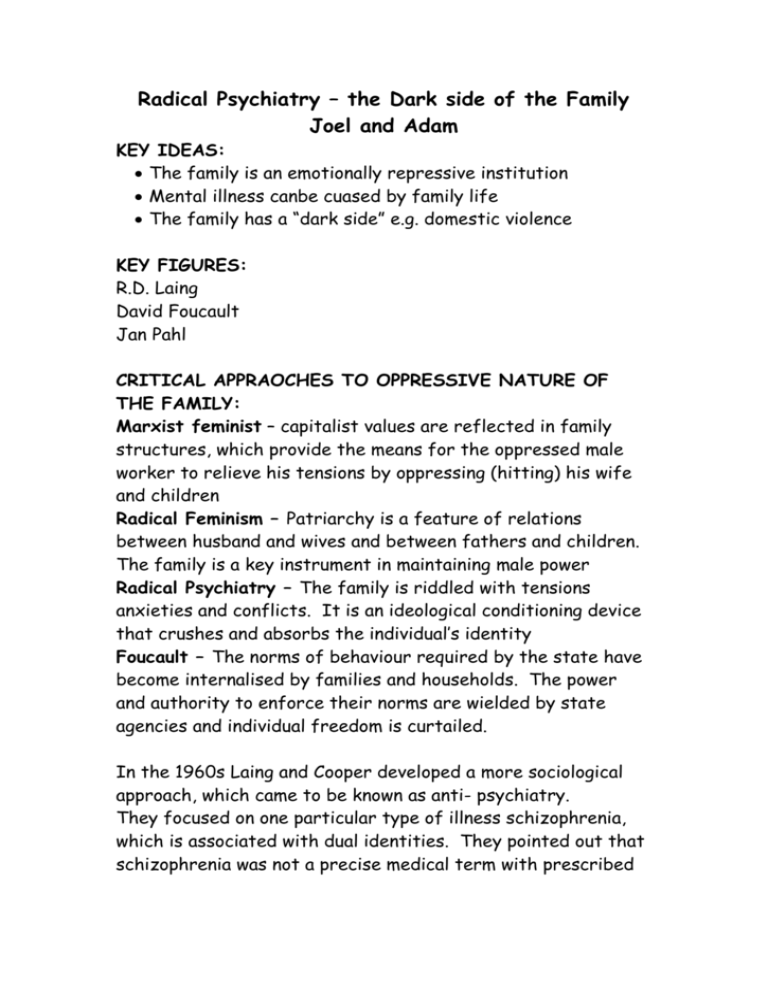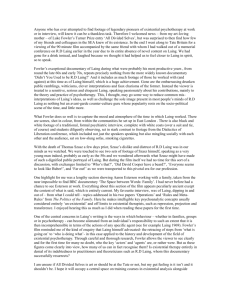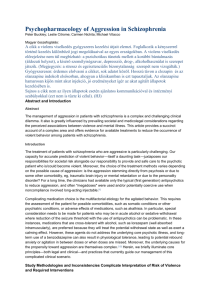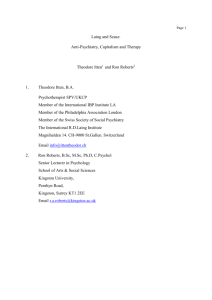Radical Psychiatry – the Dark side of the Family
advertisement

Radical Psychiatry – the Dark side of the Family Joel and Adam KEY IDEAS: The family is an emotionally repressive institution Mental illness canbe cuased by family life The family has a “dark side” e.g. domestic violence KEY FIGURES: R.D. Laing David Foucault Jan Pahl CRITICAL APPRAOCHES TO OPPRESSIVE NATURE OF THE FAMILY: Marxist feminist – capitalist values are reflected in family structures, which provide the means for the oppressed male worker to relieve his tensions by oppressing (hitting) his wife and children Radical Feminism – Patriarchy is a feature of relations between husband and wives and between fathers and children. The family is a key instrument in maintaining male power Radical Psychiatry – The family is riddled with tensions anxieties and conflicts. It is an ideological conditioning device that crushes and absorbs the individual’s identity Foucault – The norms of behaviour required by the state have become internalised by families and households. The power and authority to enforce their norms are wielded by state agencies and individual freedom is curtailed. In the 1960s Laing and Cooper developed a more sociological approach, which came to be known as anti- psychiatry. They focused on one particular type of illness schizophrenia, which is associated with dual identities. They pointed out that schizophrenia was not a precise medical term with prescribed list of symptoms, and was in fact used to cover a range of behaviour disorders. In their book “Sanity, Madness and the Family”. They featured several case studies of families in which someone had been diagnosed with schizophrenia. The person was commonly an only child, and in most cases a girl. Laing was interested in why this type of family setting should provide such significant proportion of cases. He deduced that in fact it was the complex pattern of the family dynamics, which were riddle with anxieties, tensions and conflicts that made the daughter schizophrenic. The daughter was approaching sexual maturity and could be seen as a younger version of her mother and father. Elements of jealously led to family rows. Finally the daughter would withdraw from the world of rows and emotional tensions, refusing to communicate and would start behaving in a strange manner. This nervous breakdown would result in the diagnosis of schizophrenia. In other words the family can make you mad!! Domestic Violence: The radical psychiatrists have highlighted the emotional tensions that family life can involve and Feminists have highlighted male power in marriages. These approaches combine when issues of domestic violence and abuse are considered. A clear picture emerges from studies, and more general accounts of in the mass media, show that men, whether husbands or fathers, are responsible for the majority of violence against other family members. Female violence is rare. A number of studies since 1970 have taken place, Dobash and Dobash, 1979, Pahl 1985 Stats show that: more than 79% of boys believe they are likely to use violence against women in a future relationship More than 60% of men say they would respond violently to a partner in certain situations Nearly 50% of women murders are committed by a present or a former partner Domestic violence accounts for 25% of all reported crimes according to victim support 70% of women said that the crime they worry about the most is rape Police have paid more attention to family violence.












